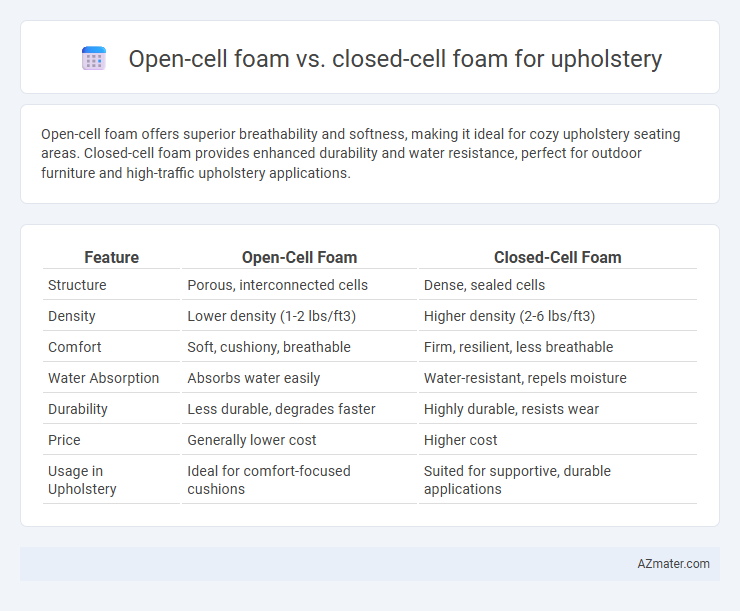Open-cell foam offers superior breathability and softness, making it ideal for cozy upholstery seating areas. Closed-cell foam provides enhanced durability and water resistance, perfect for outdoor furniture and high-traffic upholstery applications.
Table of Comparison
| Feature | Open-Cell Foam | Closed-Cell Foam |
|---|---|---|
| Structure | Porous, interconnected cells | Dense, sealed cells |
| Density | Lower density (1-2 lbs/ft3) | Higher density (2-6 lbs/ft3) |
| Comfort | Soft, cushiony, breathable | Firm, resilient, less breathable |
| Water Absorption | Absorbs water easily | Water-resistant, repels moisture |
| Durability | Less durable, degrades faster | Highly durable, resists wear |
| Price | Generally lower cost | Higher cost |
| Usage in Upholstery | Ideal for comfort-focused cushions | Suited for supportive, durable applications |
Introduction to Foam Types in Upholstery
Open-cell foam features an interconnected cellular structure yielding a softer, more breathable material ideal for upholstery applications requiring comfort and airflow. Closed-cell foam possesses a denser, non-permeable composition offering superior durability, moisture resistance, and firm support for furniture cushioning. Understanding these fundamental differences is essential for selecting the appropriate foam type based on factors like comfort level, longevity, and environmental conditions in upholstery projects.
Understanding Open-cell Foam
Open-cell foam features a porous structure with interconnected cells, offering exceptional breathability and softness, making it ideal for upholstery that requires comfort and cushioning. Its lower density allows for greater airflow, which helps in maintaining a cooler seating experience but can absorb moisture more readily compared to closed-cell foam. Understanding these characteristics is essential for selecting open-cell foam in applications where flexibility and breathability enhance user comfort.
Exploring Closed-cell Foam
Closed-cell foam offers superior durability and moisture resistance compared to open-cell foam, making it ideal for upholstery used in high-traffic or outdoor environments. Its dense structure prevents water absorption and provides enhanced support and insulation, prolonging the lifespan of furniture. This foam type also exhibits greater resistance to mold and mildew, contributing to a healthier indoor environment.
Key Differences Between Open-cell and Closed-cell Foam
Open-cell foam features a porous, airy structure that provides excellent breathability and softer cushioning, making it ideal for upholstery requiring comfort and flexibility. Closed-cell foam has a dense, rigid composition with high resistance to moisture, chemicals, and compression, offering superior durability and support for heavy-use furniture. Thermal insulation, water resistance, and weight are key differentiators, with closed-cell foam outperforming open-cell foam in these areas for long-lasting upholstery applications.
Comfort and Cushioning: Which Foam Performs Better?
Open-cell foam offers superior breathability and softness, making it ideal for comfortable upholstery that hugs the body with gentle cushioning. Closed-cell foam, denser and more rigid, provides firmer support and better durability but less cushioning flexibility. For upholstery focused on comfort and cushioning, open-cell foam generally performs better by delivering a plush, adaptive feel that enhances seating experience.
Durability and Longevity Comparison
Closed-cell foam offers superior durability and longevity for upholstery due to its dense structure, which resists moisture, mold, and physical compression over time. Open-cell foam, while more breathable and softer, tends to break down faster under heavy use, absorbing moisture that may lead to quicker deterioration. For upholstery applications requiring long-term resilience, closed-cell foam is the preferred choice for maintaining shape and structural integrity.
Moisture Resistance and Breathability
Closed-cell foam offers superior moisture resistance due to its dense structure, preventing water absorption and mold growth in upholstery applications. Open-cell foam provides enhanced breathability with its porous design, allowing air circulation that reduces heat buildup but can trap moisture over time. Selecting between these foams depends on balancing moisture protection requirements with comfort and ventilation needs in upholstered furniture.
Cost Considerations for Upholstery Projects
Open-cell foam typically costs less than closed-cell foam, making it a budget-friendly option for upholstery projects where cushioning and comfort are priorities. Closed-cell foam, while more expensive, offers superior durability and moisture resistance, which can reduce long-term maintenance costs. Choosing between the two depends on balancing initial expenditure with project requirements for resilience and lifespan.
Best Applications for Each Foam Type
Open-cell foam offers superior breathability and softness, making it ideal for upholstery in furniture that prioritizes comfort and airflow, such as sofas and cushioned chairs. Closed-cell foam provides excellent water resistance and higher durability, making it better suited for outdoor furniture or high-traffic areas requiring firm support and long-lasting performance. Choosing between open-cell and closed-cell foam depends on the need for comfort versus resilience in specific upholstery applications.
Choosing the Right Foam for Your Upholstery Needs
Open-cell foam offers superior breathability and softness, making it ideal for upholstery projects requiring comfort and cushioning with flexibility. Closed-cell foam provides greater durability, moisture resistance, and support, suited for high-traffic furniture or outdoor applications where longevity and firmness are essential. Selecting the right foam depends on balancing comfort preferences, durability requirements, and environmental exposure specific to your upholstery needs.

Infographic: Open-cell foam vs Closed-cell foam for Upholstery
 azmater.com
azmater.com